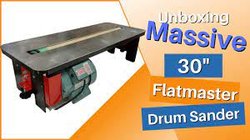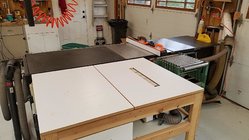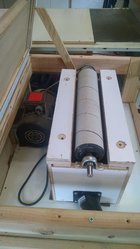-
It's time to cast your vote in the December 2025 Turning Challenge. (click here for details) -
Congratulations to Pat White for "Sicilian Mosaic" being selected as Turning of the Week for December 29, 2025 (click here for details) -
Welcome new registering member. Your username must be your real First and Last name (for example: John Doe). "Screen names" and "handles" are not allowed and your registration will be deleted if you don't use your real name. Also, do not use all caps nor all lower case.
You are using an out of date browser. It may not display this or other websites correctly.
You should upgrade or use an alternative browser.
You should upgrade or use an alternative browser.
Flatmaster drum sander
- Thread starter Rusty Nesmith
- Start date
- Joined
- Feb 28, 2021
- Messages
- 1,778
- Likes
- 1,592
- Location
- Roulette, PA
- Website
- www.reallyruralwoodworks.com
I plan to fabricate one out of my Harbor Freight 12-36 lathe as soon as I can afford my new Jet 1840 - that'd give me pretty much a 36 inch drum sander - probably most difficult part would be engineering the feed roller system (but I do have a couple ideas on it)
I have not used it, but I know a lot of intarsia folks speak pretty highly of it.
Of course, it is for different purposes than other traditional drum sanders. This type of drum sander won’t make a piece coplanar like a drum sander with a feed roller will.
Of course, it is for different purposes than other traditional drum sanders. This type of drum sander won’t make a piece coplanar like a drum sander with a feed roller will.
The manufacturer, Stockroom Supply, also sells DIY (V-Drum) drum kits. I built one about 11 years ago using their drum kit and a formica top they had at the time.
I followed their plans and it worked as advertised.
There is, however, a caveat. Their Flatmaster (and the DIY version I built) is a surface sander, not a flattening sander. The amount of material taken off (and correspondingly the depth of cut) depends on the pressure you use when passing your material over the spinning drum. You can get a nice smooth surface, but it may not be flat.
I used my V-drum a lot for things like resurfacing cabinet faces, etc. and it was fine, but when I started doing segmented work it proved to be the wrong tool for the job. In segmenting, it is not enough to get a smooth surface ... it has to be flat our you won't get consisten, tight glue joints.
So, depending on what you intend to do with it, the Flatmaster may or may not be the right tool.
I followed their plans and it worked as advertised.
There is, however, a caveat. Their Flatmaster (and the DIY version I built) is a surface sander, not a flattening sander. The amount of material taken off (and correspondingly the depth of cut) depends on the pressure you use when passing your material over the spinning drum. You can get a nice smooth surface, but it may not be flat.
I used my V-drum a lot for things like resurfacing cabinet faces, etc. and it was fine, but when I started doing segmented work it proved to be the wrong tool for the job. In segmenting, it is not enough to get a smooth surface ... it has to be flat our you won't get consisten, tight glue joints.
So, depending on what you intend to do with it, the Flatmaster may or may not be the right tool.
I have one and have always had trouble adjusting for different grits. The courser abrasives are thicker, so every time you change grit you have to make adjustments. It takes a lot of fiddling around. It has a velcro covered drum, and uses the speed of the drum to extend the velcro. So the abrasive just kisses the wood. Again some fiddling around with adjustment. You adjust one side of the drum and the other. You have to attempt to get close to parallel with the table and abrasive. Always feel like I spend more time fiddling than sanding. I have very few hours on the machine, pretty much a waste of money in my opinion.
Last edited:
I looked at one as a smaller footprint thickness sander. I read enough reviews to know that it was not going to do what I needed it to do which was thickness sand end grain blocks to a precise thickness as part of making wooden type for printing.
I made my own several years back. I liked it. It worked great. I only sold it because I needed room for my new thickness sander. The flat master is great for end grain and one-side finishing. But it's not for the same tasks as a thickness sander.
Here is a photo of the one I build. I think it cost me about $250 to build.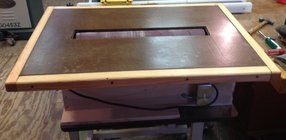
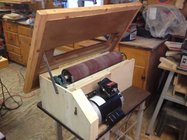
Here is a photo of the one I build. I think it cost me about $250 to build.


I have a smaller sand flee. As said above "it is a surface sander and not a thickness sander".
Rusty, I bought my flatmaster 6 or 7 years ago when I started doing segment turnings. it's perfect for flattening a ring. I have used it for many other things since and absolutely love it. I bought the 18" wide kit and built the stand/housing for it. agree with others that it's a surface sander, not a thickness sander, but you'd be surprise how fast it will shave a surface with 60g sandpaper on it. most of them time I have it loaded sith 100-120g but it takes only 60-90 seconds to change paper.Has anybody seen or used a Flatmaster drum sander. I have been watching a lot of videos about it and it looks pretty good. It is quite a bit cheaper than the other style drum sanders and a lot lighter to move by hand.
View attachment 47342
Attachments
Thanks for the review Dave. I would be mostly using it for segmented rings and small things. The largest thing I would probably run through it would be a cutting board.

